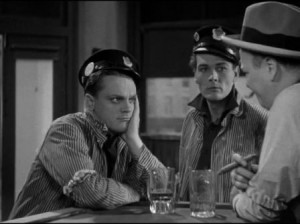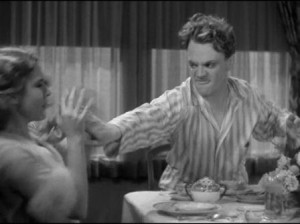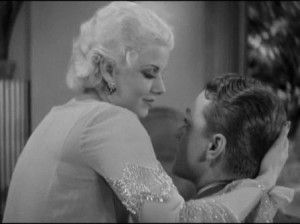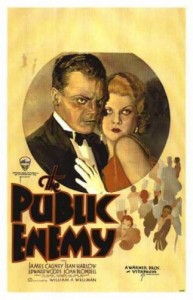… I ain’t so tough. – Tom Powers
The Public Enemy marks perhaps one of the highlights of the gangster film genre even now, seventy years after its release in 1931. At their core, gangster films are all more or less the same and from my perspective the differences between them are in realism and the avoidance of clichés.
Granted, in 1931 it would have been hard to utilize a lot of the clichés which we currently have on the gangster genre. The Public Enemy is raw and powerful which is perhaps to some extent due to the pre-code nature of the film but also the no nonsense directorial work of William Wellman and the near perfect casting of James Cagney as Tom Powers, the small time gangster whose rise – and ultimate demise- the film chronicles.
Produced by Warner Brothers, who cut their teeth early in the gangster genre, The Public Enemy has you rooting for the hero – Tom Powers- if hero is the right word. Although originally cast as the lesser thug of Matt Doyle, James Cagney ultimately swapped roles with Edward Woods to take on the role of Tom Powers, which for some is still synonymous with the career of James Cagney.
 Although the violence (including the shooting of a horse) all happens off screen due to the censors of the time, it actually adds deep drama to the goings on given today’s graphic showing of all things bloody. Take for example, the (at the time) controversial graphic nature of The Untouchables, which in itself is now dated in the area.
Although the violence (including the shooting of a horse) all happens off screen due to the censors of the time, it actually adds deep drama to the goings on given today’s graphic showing of all things bloody. Take for example, the (at the time) controversial graphic nature of The Untouchables, which in itself is now dated in the area.
As an aside, some versions are of later releases with some of the more controversial scenes omitted to please the censors, with the two main scenes missing are the “morning after” scene I mention below which is a true loss and is for my money quite important scene in the picture. The other is a scene, perhaps a throwaway one, where Matt and Tom are being fitted for suits by an extremely effeminate tailor. It should be there for completeness but you don’t miss anything by deleting it either.
 The little on screen violence which we are privy too does look a bit staged – with the punches looking more like clubbing than anything else. We also have the memorable scene where James Cagney smashes a grapefruit in to Mae Clark’s face, which although stil debated somewhat, appears never to have been originally planned to make it on screen.
The little on screen violence which we are privy too does look a bit staged – with the punches looking more like clubbing than anything else. We also have the memorable scene where James Cagney smashes a grapefruit in to Mae Clark’s face, which although stil debated somewhat, appears never to have been originally planned to make it on screen.
There is also lots of things perhaps most miss or perhaps just forget given how good a film The Public Enemy is. Little things, like the black cat which crosses the path of Putty Nose just before Tom and Matt corner and ultimately murder him. Also, which is somewhat typical for Warners, is a bit of social commentary.
This commentary comes out most both in the perspectives on prohibition which feed the gang culture of the film. Somewhat less obvious is the angst Tom feels the morning after a drunken night where Mae Clark seduces him. Almost odd on the surface that Tom, the stereotypical gangster, would feel ire at this or even perhaps guilt at straying from flame Gwen Allen, played by Jean Harlow.
There is also the interesting dynamic of Tom’s family life, which for the most part is very normal without any deep 1990s era trauma to drive later events. There is an equally important dichotomy with Tom’s brother Mike, who is a straight laced gent who leaves the family to serve in World War One. The idea is floated that both soldiers and gangsters are nothing more than killers alike, the difference being only one of perspective. Bravo Warners!
 Jean Harlow, the vixen who truly never got to spread her wings, strangely gets second billing in what is really a part only slightly above bit status. While some would claim later that her performance in The Public Enemy is her worst, I found it merely unimpressive, but not in a bad way.
Jean Harlow, the vixen who truly never got to spread her wings, strangely gets second billing in what is really a part only slightly above bit status. While some would claim later that her performance in The Public Enemy is her worst, I found it merely unimpressive, but not in a bad way.
There simply isn’t much here for her to work with, as her part is small and the dialogue is at times horrendous. Even Olivier can’t make filet mignon from spam. And yes, there is a visual no one needed.
Readily available without much effort, this is still a timeless classic which deserves a place on your shelf, iPad, etc. It is a very tight and powerful without any room for fluff, from the opening credits to the opening bang- er, thud.
